 W
WA motorcycle, often called a motorbike, bike, or cycle, is a two- or three-wheeled motor vehicle. Motorcycle design varies greatly to suit a range of different purposes: long-distance travel, commuting, cruising, sport, and off-road riding. Motorcycling is riding a motorcycle and being involved in other related social activity such as joining a motorcycle club and attending motorcycle rallies.
 W
WMotorcycle testing and measurement includes a range of more than two dozen statistics giving the specifications of the motorcycle, and the actual performance, expressed by such things as the output of the engine, and the top speed or acceleration of the motorcycle. Most parameters are uncontroversial and claims made by manufacturers are generally accepted without verification. These might include simple measurements like rake, trail, or wheelbase, or basic features, such as the type of brakes or ignition system.
 W
WAn anti-lock braking system (ABS) is a safety anti-skid braking system used on aircraft and on land vehicles, such as cars, motorcycles, trucks, and buses. ABS operates by preventing the wheels from locking up during braking, thereby maintaining tractive contact with the road surface and allowing the driver to maintain more control over the vehicle.
 W
WAutomatic lubrication refers to a lubrication system on a two-stroke engine, in which the oil is automatically mixed with fuel and manual oil-fuel pre-mixing is not necessary. The oil is contained in a reservoir that connects to a small oil pump in the engine, which needs to be periodically refilled.
 W
WCamber thrust and camber force are terms used to describe the force generated perpendicular to the direction of travel of a rolling tire due to its camber angle and finite contact patch. Camber thrust is generated when a point on the outer surface of a leaned and rotating tire, that would normally follow a path that is elliptical when projected onto the ground, is forced to follow a straight path while coming in contact with the ground, due to friction. This deviation towards the direction of the lean causes a deformation in the tire tread and carcass that is transmitted to the vehicle as a force in the direction of the lean.
 W
WA combined braking system (CBS), also called linked braking system (LBS), is a system for linking front and rear brakes on a motorcycle or scooter. In this system, the rider's action of depressing one of the brake levers applies both front and rear brakes. The amount of each brake applied may be determined by a proportional control valve. This is distinct from integrated brakes, where applying pressure to the rear brake pedal only applies some braking force to the front brake.
 W
WThe Comstar wheel, sometimes referred to as Com-stars or stylised as ComStar, was a composite motorcycle wheel that Honda fitted to many of its motorcycles from 1977 to the mid 1980s. Its design allowed it the option of being fitted with tubeless tyres and its use on the Honda CX500 was the first time tubeless tyres had been designed for a production motorcycle.
 W
WA motorcycle fork connects a motorcycle's front wheel and axle to its frame, typically via a yoke, also known as a triple clamp, which consists of an upper yoke joined to a lower yoke via a steering stem, a shaft that runs through the steering head, creating the steering axis. Most forks incorporate the front suspension and front brake, and allow the front wheel to rotate about the steering axis so that the bike may be steered. Most handlebars attach to the top clamp in various ways, while clip-on handlebars clamp to the fork tubes, either just above or just below the upper triple clamp.
 W
WEdelbrock, LLC is an American manufacturer of specialty automotive and motorcycle parts. The company is headquartered in Olive Branch, Mississippi, with a Southern California R&D Tech Center located in Cerritos, CA. The Edelbrock Sand Cast and Permanent Mold Manufacturing foundries are located in San Jacinto, CA. Edelbrock has two facilities in North Carolina: the Edelbrock Carburetor Division in Sanford, and the Edelbrock Race Center in Mooresville.
 W
WElectric motorcycles and scooters are plug-in electric vehicles with two or three wheels. The electricity is stored on board in a rechargeable battery, which drives one or more electric motors. Electric scooters have a step-through frame.
 W
WA motorcycle fairing is a shell placed over the frame of some motorcycles, especially racing motorcycles and sport bikes, with the primary purpose to reduce air drag. The secondary functions are the protection of the rider from airborne hazards and wind-induced hypothermia and of the engine components in the case of an accident. A motorcycle windshield will almost always be integrated into the design of the fairing.
 W
WFender is the American English term for the part of an automobile, motorcycle or other vehicle body that frames a wheel well. Its primary purpose is to prevent sand, mud, rocks, liquids, and other road spray from being thrown into the air by the rotating tire. Fenders are typically rigid and can be damaged by contact with the road surface.
 W
WA motorcycle fork connects a motorcycle's front wheel and axle to its frame, typically via a yoke, also known as a triple clamp, which consists of an upper yoke joined to a lower yoke via a steering stem, a shaft that runs through the steering head, creating the steering axis. Most forks incorporate the front suspension and front brake, and allow the front wheel to rotate about the steering axis so that the bike may be steered. Most handlebars attach to the top clamp in various ways, while clip-on handlebars clamp to the fork tubes, either just above or just below the upper triple clamp.
 W
WA motorcycle fork connects a motorcycle's front wheel and axle to its frame, typically via a yoke, also known as a triple clamp, which consists of an upper yoke joined to a lower yoke via a steering stem, a shaft that runs through the steering head, creating the steering axis. Most forks incorporate the front suspension and front brake, and allow the front wheel to rotate about the steering axis so that the bike may be steered. Most handlebars attach to the top clamp in various ways, while clip-on handlebars clamp to the fork tubes, either just above or just below the upper triple clamp.
 W
WA gyrocar is a two-wheeled automobile. The difference between a bicycle or motorcycle and a gyrocar is that in a bike, dynamic balance is provided by the rider, and in some cases by the geometry and mass distribution of the bike itself, and the gyroscopic effects from the wheels. Steering a motorcycle is done by precessing the front wheel. In a gyrocar, balance was provided by one or more gyroscopes, and in one example, connected to two pendulums by a rack and pinion.
 W
WA motorcycle handlebar is a tubular component of a motorcycle's steering mechanism. Handlebars provide a mounting place for controls such as brake, throttle, clutch, horn, light switches and rear view mirrors; and they help to support part of the rider's weight. Even when a handlebar is a single piece it is usually referred to in the plural as handlebars.
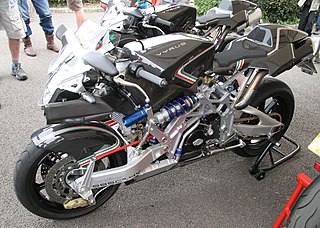 W
WHub-center steering (HCS) is one of several different types of front end suspension/steering mechanisms used in motorcycles and cargo bicycles. Hub-center steering is characterized by the steering pivot points being inside the hub of the wheel, rather than above the wheel in the headstock as in the traditional layout. Most hub-center arrangements employ a swingarm that extends from the bottom of the engine/frame to the centre of the front wheel.
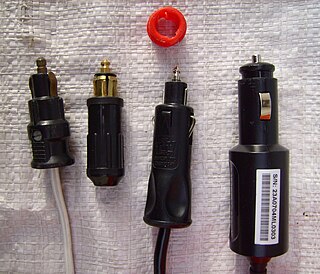 W
WISO 4165 is a standard adopted by the International Organization for Standardization (ISO) that describes a double-pole DC connector to supply between 12 and 24 V DC at up to 12 amps to appliances in vehicles. Although roughly similar in design to an automotive accessory receptacle, the ISO 4165 connector is shorter and smaller in diameter. It was originally a standard fitting on all the German military vehicles during World War II.
 W
WA motorcycle lift is a lift table that is designed to handle motorcycles. Many repair shops use such lifts to bring the vehicle off of the ground and up to a level so that the mechanic does not have to put any strain on his or her back or lay upon the ground to perform any kind of work upon the vehicle. Also, motorcycle enthusiasts have put these lifts into their home garages so that they can perform simple maintenance jobs such as changing the oil and cleaning the bike without having to get down on the ground. These lifts are typically made of steel and powered by air or hydraulic cylinders that handle load capacities up to 1,500 lb (680 kg).
 W
WMotorcycle braking systems have varied throughout time, as motorcycles evolved from bicycles with an engine attached, to the 220 mph (350 km/h) prototype motorcycles seen racing in MotoGP. Most systems work by converting kinetic energy into thermal energy (heat) by friction. On motorcycles, approximately 70% of the braking effort is performed by the front brake. This however can vary for individual motorcycles; longer-wheelbase types having more weight biased rearward, such as cruisers and tourers, can have a`greater effort applied by the rear brake. In contrast, sports bikes with a shorter wheelbase and more vertical fork geometry can tolerate higher front braking loads. For these reasons, motorcycles tend to have a vastly more powerful front brake compared to the rear.
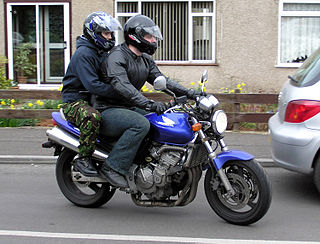 W
WA pillion is a secondary pad, cushion, or seat behind the main seat or saddle on a horse, motorcycle, bicycle or moped. A passenger in this seat is said to "ride pillion". The word is derived from the Scottish Gaelic for "little rug", pillean, from the Latin pellis, "animal skin". One or more pelts often were used as a secondary seat on horseback; the usage has carried over to motorcycles.
 W
WPolini S.p.A. is an Italian manufacturer of tuning parts for motorcycles, mopeds, and scooters. Among other products, they produce cylinders and variators for both racing and road use. They also produce pocket bikes with 50cc up to 15 hp.
 W
WPowder coating is a type of coating that is applied as a free-flowing, dry powder. Unlike conventional liquid paint which is delivered via an evaporating solvent, powder coating is typically applied electrostatically and then cured under heat or with ultraviolet light. The powder may be a thermoplastic or a thermoset polymer. It is usually used to create a hard finish that is tougher than conventional paint. Powder coating is mainly used for coating of metals, such as household appliances, aluminium extrusions, drum hardware, automobiles, and bicycle frames. Advancements in powder coating technology like UV curable powder coatings allow for other materials such as plastics, composites, carbon fiber, and MDF to be powder coated due to the minimum heat and oven dwell time required to process these components.
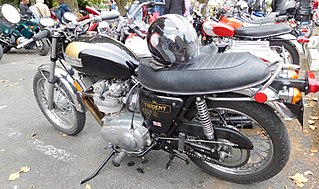 W
WA motorcycle seat is where rider sits, and may also accommodate a passenger.
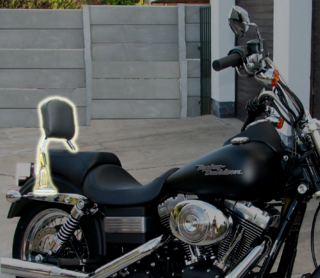 W
WA sissy bar, also called a "sister bar" or "passenger backrest" is an addition to the rear of a bicycle or motorcycle that allows the rider or passenger to recline against it while riding. Alternatively it can serve as an anchor point or support for mounting luggage or equipment that is not part of the bike. They can serve as one of the main mounts securing the rear fender to the motorcycle. Over the years the sissy bars have been a focal point of expression for the bike builder. Custom sissy bar designs can be simple or extravagant. They can be built for comfort, purpose, style or a combination of all three.
 W
WA motorcycle fork connects a motorcycle's front wheel and axle to its frame, typically via a yoke, also known as a triple clamp, which consists of an upper yoke joined to a lower yoke via a steering stem, a shaft that runs through the steering head, creating the steering axis. Most forks incorporate the front suspension and front brake, and allow the front wheel to rotate about the steering axis so that the bike may be steered. Most handlebars attach to the top clamp in various ways, while clip-on handlebars clamp to the fork tubes, either just above or just below the upper triple clamp.
 W
WA steering damper, or steering stabiliser is a damping device designed to inhibit an undesirable, uncontrolled movement or oscillation of a vehicle steering mechanism, a phenomenon known in motorcycling as wobble.
 W
WA motorcycle trailer is either a trailer used to carry motorcycles or one to be pulled by a motorcycle in order to carry additional gear.
 W
WA motorcycle fork connects a motorcycle's front wheel and axle to its frame, typically via a yoke, also known as a triple clamp, which consists of an upper yoke joined to a lower yoke via a steering stem, a shaft that runs through the steering head, creating the steering axis. Most forks incorporate the front suspension and front brake, and allow the front wheel to rotate about the steering axis so that the bike may be steered. Most handlebars attach to the top clamp in various ways, while clip-on handlebars clamp to the fork tubes, either just above or just below the upper triple clamp.
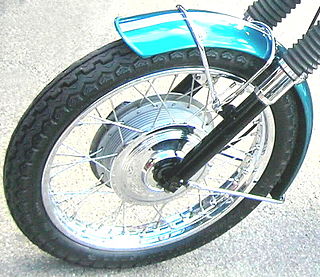 W
WThe Dunlop K81 TT100 is a motorcycle tyre thought to be an "obligatory" performance upgrade and a tyre of choice with sporting street motorcyclists during the late 1960s and 1970s due to their shape and relatively sticky compound.
 W
WA twistgrip is a handle that can be twisted to operate a control. It is commonly found as a motorcycle's right handlebar grip to control the throttle, but is sometimes found elsewhere, such as on a bicycle as a gearshift, and in helicopters.